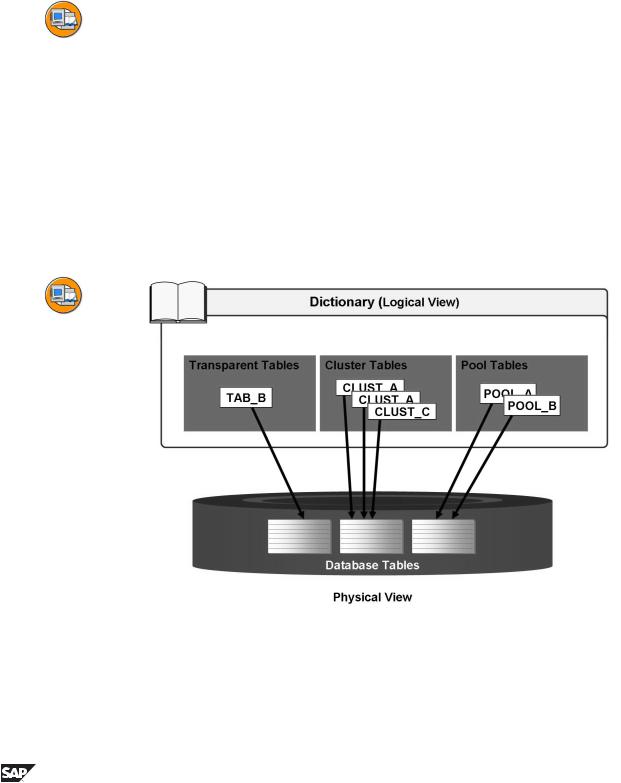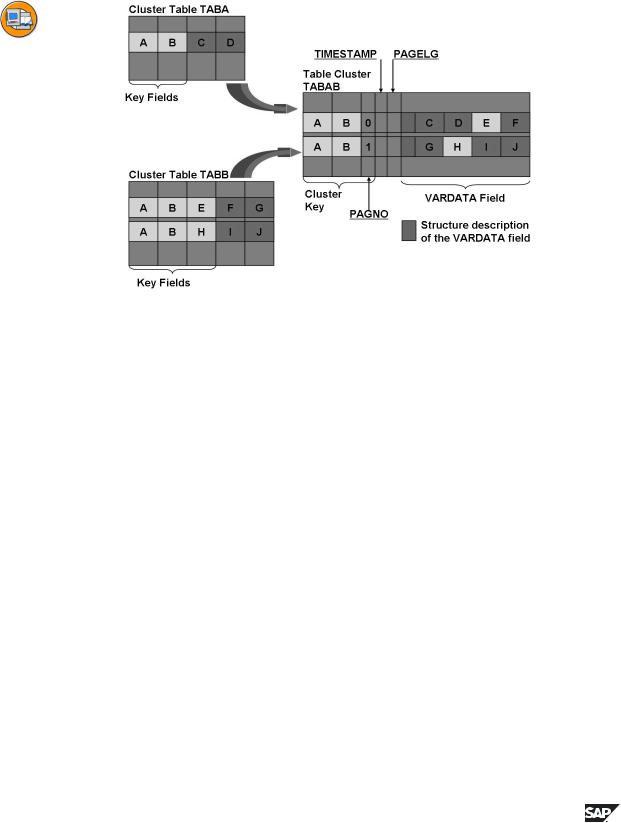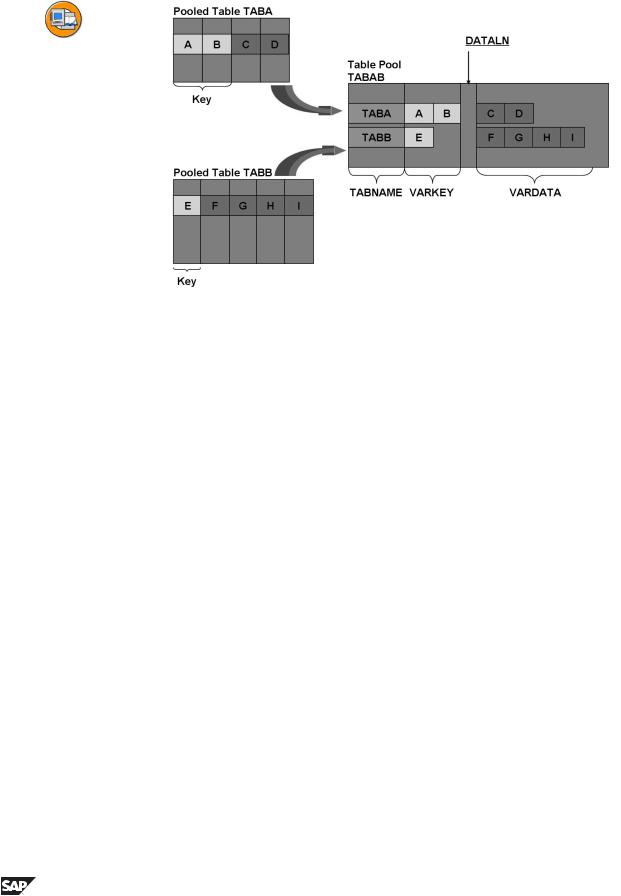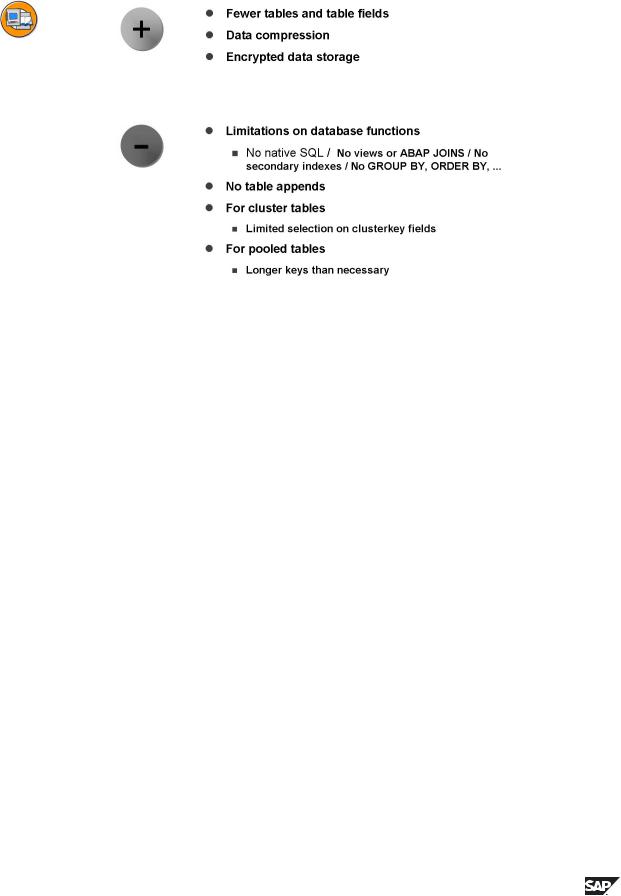
- •Icons in Body Text
- •Introduction to the Dictionary
- •Overview of the functions
- •Data objects in the ABAP Dictionary
- •Data types
- •Exercise 1: Basic Data Types
- •Exercise 2: Simple and Nested Structures
- •Exercise 4: Deep Structures
- •Tables
- •Summary
- •Exercise 5: Tables in the ABAP Dictionary
- •Pooled and cluster tables
- •Performance During Table Access
- •Improved Performance through Access per Index
- •Improving the Performance through Table Buffering
- •Exercise 6: Performance Aspects with Table Access
- •Task 1:
- •Input Checks
- •Input check via the technical domains
- •Object Dependencies
- •Activation and Where-Used List
- •Changes to Tables
- •Database Changes to Transparent Tables
- •Enhancement of SAP Standard Tables
- •Exercise 9: Changes to Database Tables
- •Views and Maintenance Views
- •Restricted or Enhanced Views on Database Tables
- •Exercise 11: Views
- •Creating Maintenance Views
- •Exercise 12: Maintenance Views
- •Search Helps
- •Input helps
- •Exercise 13: Search Helps
- •Table ZEMPLOY##
- •Table ZDEPMENT##
- •Table ZEMPLOY##
- •Table ZEMPLOY##
- •Table ZDEPMENT##
- •Table ZDEPMENT##
- •Check table T000
- •Check table SCARR
- •Check table ZDEPMENT##
- •Check table SCURX
- •Check table STRAVELAG
- •Check table ZDEPMENT##
- •Check table T002

Unit 2: Data objects in the ABAP Dictionary |
BC430 |
Lesson: Special SAP Tables
Lesson Overview
You will learn about pooled and cluster tables
Lesson Objectives
After completing this lesson, you will be able to:
•Describe table types in the SAP system apart from the transparent tables
•Distinguish pooled and cluster tables from one another
•Describe the advantages and disadvantages of pooled and cluster tables.
Business Example
In the performance checks of some applications, you have come across select statements, which apparently access other tables in the database than referred to in the respective ABAP coding.
Pooled and cluster tables
Figure 26: Overview of the DB table types
In addition to transparent tables, where the definition in the ABAP Dictionary and in the database are identical, there are pooled and cluster tables in the R/3 system.
68 |
© 2007 SAP AG. All rights reserved. |
2006/Q2 |

BC430 |
Lesson: Special SAP Tables |
Pooled and cluster tables are characterized by the fact that several tables logically defined in the ABAP Dictionary are combined in a physical database table (table pool or cluster).
Figure 27: Cluster tables
The idea of cluster tables is that you store functionally dependent data which is divided among different tables in one database table. Accordingly, the intersection of the key fields of the cluster tables is formed by the key of the table cluster (cluster key).
The data dependent on one cluster key are stored in the VARDATA field of the table cluster. If the VARDATA field does not have the capacity to take on all dependent data, the database interface creates an overflow record. The uniqueness within the table cluster is guaranteed by the PAGNO field.
The content of the VARDATA field is compressed by the database interface. Accordingly, the VARDATA field contains a description for decompressing its data. The TIMESTAMP and PAGELG fields contain administrative information.
2006/Q2 |
© 2007 SAP AG. All rights reserved. |
69 |

Unit 2: Data objects in the ABAP Dictionary |
BC430 |
Figure 28: Pooled Tables
The basic idea of a table pool, as opposed to table clusters, is the storage of data records from the tables defined in the ABAP Dictionary that are not dependent on one another. You would like to combine small R/3 tables to a database table.
In the example above, you can recognize that the intersection of the key fields of TABA and TABB is empty. Despite this, the data records from TABA and TABB are stored in the TABAB table pool.
The key for a data record of the TABAB table pool consists of both the fields TABNAME and VARKEY. The TABNAME field assumes the name of the pooled table. The VARKEY field consists of the concatenation of the key fields of the pooled table. This arises in the necessity that the key fields of a pooled table must be of the type C.
In the VARDATA field, the non-key fields of the pooled tables are stored in an unstructured way, in compressed form by the database interface. The DATALN field contains the length of the VARDATA field.
70 |
© 2007 SAP AG. All rights reserved. |
2006/Q2 |

BC430 |
Lesson: Special SAP Tables |
Figure 29: Describe the advantages and disadvantages of pooled and cluster tables
The decisive advantage of pooled and cluster tables is that the data can be stored in compressed form in the database. This reduces the memory space required as well as the network load.
The combination of tables into table pools to table clusters means less tables and the compressing means less fields in the database. The result is that fewer different SQL statements are carried out.
Pooled and cluster tables are not stored as separate tables in the database. In this way, the administration becomes simpler. With cluster tables, functionally dependent data are read together, which results in fewer database accesses.
The decisive disadvantage lies in the restricted database functionality. It is not possible for non-key fields to create an index. There are neither primary indices nor indices on a subset of the key fields. The use of database views or ABAP JOINs is also ruled out, as are Table Appends. You can access the data in pooled or cluster tables only via OPEN SQL (no Native SQL).
For pooled tables, only the WHERE conditions for key fields and for cluster tables, only the WHERE conditions for the fields of the cluster key (subset of the key fields) are transferred to the database. ORDER BY (or GROUP BY) clauses are not transferred for non-key fields. You need longer keys than semantically necessary for pooled tables.
2006/Q2 |
© 2007 SAP AG. All rights reserved. |
71 |

Unit 2: Data objects in the ABAP Dictionary |
BC430 |
Lesson Summary
You should now be able to:
•Describe table types in the SAP system apart from the transparent tables
•Distinguish pooled and cluster tables from one another
•Describe the advantages and disadvantages of pooled and cluster tables.
72 |
© 2007 SAP AG. All rights reserved. |
2006/Q2 |

BC430 |
Unit Summary |
Unit Summary
You should now be able to:
•Create domains and use them in data elements
•Define data elements and use them as the basis for defining data objects in ABAP programs
•Define structures and use them as the basis for defining data objects in ABAP programs
•Define internal tables and use them as the basis for defining data objects in ABAP programs
•Define complex (nested / deep) structures and use them as the basis for defining data objects in ABAP programs
•Define global constants with the help of a type pool and use them in ABAP programs
•Create Tables
•Use the two-level domain concept
•Define the technical settings of a table
•Create and use include structures
•Describe table types in the SAP system apart from the transparent tables
•Distinguish pooled and cluster tables from one another
•Describe the advantages and disadvantages of pooled and cluster tables.
2006/Q2 |
© 2007 SAP AG. All rights reserved. |
73 |

Unit Summary |
BC430 |
74 |
© 2007 SAP AG. All rights reserved. |
2006/Q2 |
